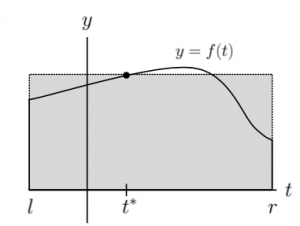That is what I have now. A function f(t) and quadrant on my paper. If I want to calculate the area under the function, motivation of integration appears.
We set two different number on the x-axis like l and r, making it a interval [l,r].Then we find a number in this interval,t*,and calculate the value of f(t*).
So the area approximately equals to f(t*)·(r-l)

For the deeper and more precise calculation, we divide the interval [r-l] into three equal sub-intervals like t1, t2 and t3.
Then t1=t2=t3=(r-l)/3.
And we find three number t1*, t2* and t3* which within three sub-intervals respectively, calculating their value of y-axis such as f(t1*), f(t2*) and f(t3*)
Therefore, the refined area under the function can be presented as A=f(t1*)·t1+f(t2*)·t2+f(t3*)·t3
With this trial, we can divide [l,r] into more and more sub-intervals to reach the most precise area that I want to calculate.
Of course, area only can be calculated in some functions like continuous functions, for the reason that a non-continuous function does not have closed area.
Written by Yuki Zhang(50653161) and Denise Wang(24482168)